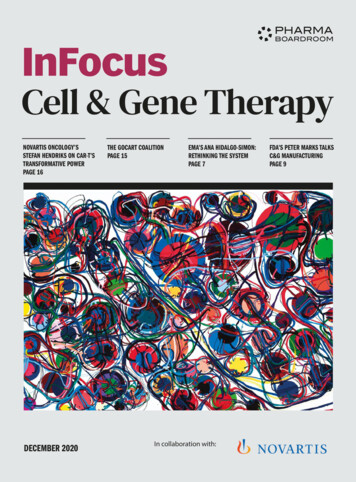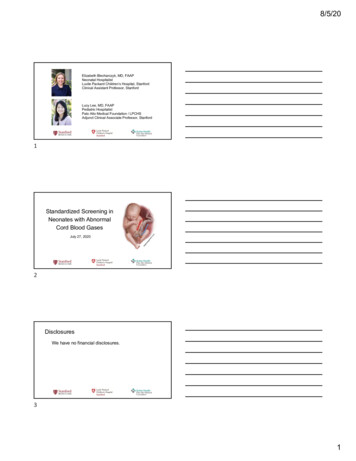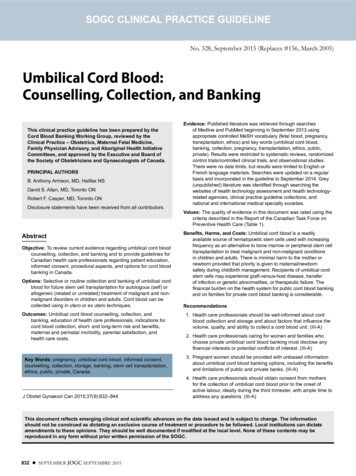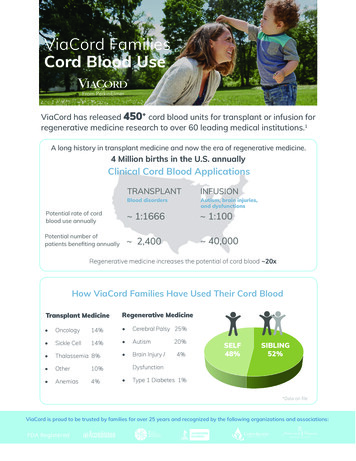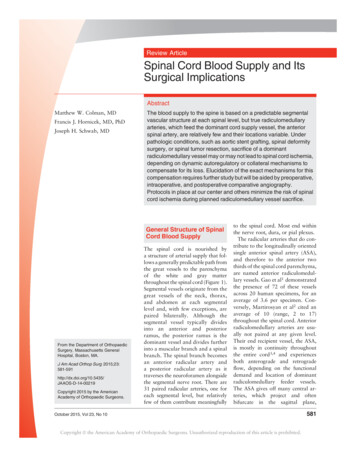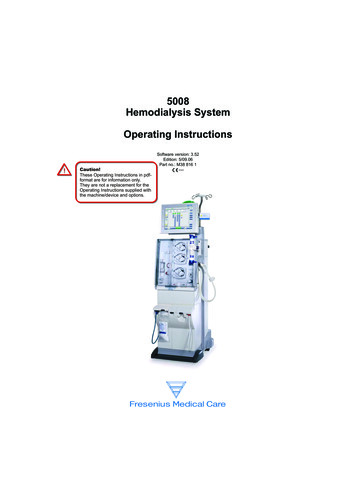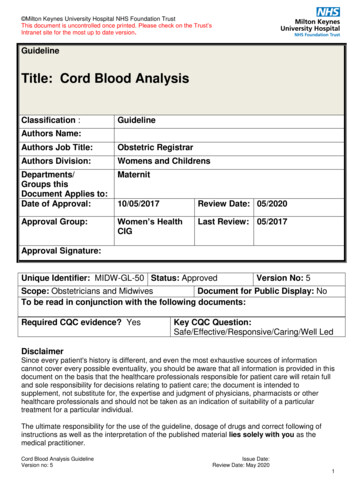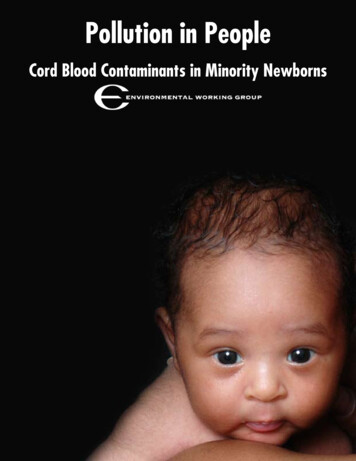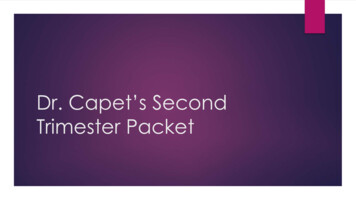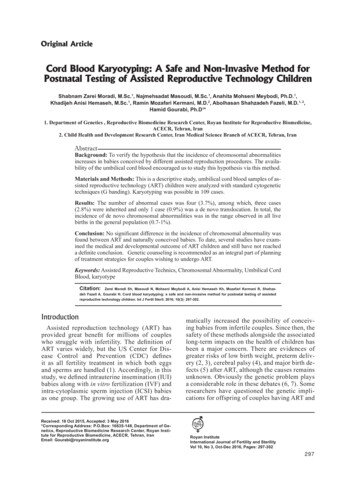
Transcription
Original ArticleCord Blood Karyotyping: A Safe and Non-Invasive Method forPostnatal Testing of Assisted Reproductive Technology ChildrenShabnam Zarei Moradi, M.Sc.1, Najmehsadat Masoudi, M.Sc.1, Anahita Mohseni Meybodi, Ph.D.1,Khadijeh Anisi Hemaseh, M.Sc.1, Ramin Mozafari Kermani, M.D.2, Abolhasan Shahzadeh Fazeli, M.D.1, 2,Hamid Gourabi, Ph.D1*1. Department of Genetics , Reproductive Biomedicine Research Center, Royan Institute for Reproductive Biomedicine,ACECR, Tehran, Iran2. Child Health and Development Research Center, Iran Medical Science Branch of ACECR, Tehran, IranAbstractBackground: To verify the hypothesis that the incidence of chromosomal abnormalitiesincreases in babies conceived by different assisted reproduction procedures. The availability of the umbilical cord blood encouraged us to study this hypothesis via this method.Materials and Methods: This is a descriptive study, umbilical cord blood samples of assisted reproductive technology (ART) children were analyzed with standard cytogenetictechniques (G banding). Karyotyping was possible in 109 cases.Results: The number of abnormal cases was four (3.7%), among which, three cases(2.8%) were inherited and only 1 case (0.9%) was a de novo translocation. In total, theincidence of de novo chromosomal abnormalities was in the range observed in all livebirths in the general population (0.7-1%).Conclusion: No significant difference in the incidence of chromosomal abnormality wasfound between ART and naturally conceived babies. To date, several studies have examined the medical and developmental outcome of ART children and still have not reacheda definite conclusion. Genetic counseling is recommended as an integral part of planningof treatment strategies for couples wishing to undergo ART.Keywords: Assisted Reproductive Technics, Chromosomal Abnormality, Umbilical CordBlood, karyotypeCitation:Zarei Moradi Sh, Masoudi N, Mohseni Meybodi A, Anisi Hemaseh Kh, Mozafari Kermani R, Shahzadeh Fazeli A, Gourabi H. Cord blood karyotyping: a safe and non-invasive method for postnatal testing of assistedreproductive technology children. Int J Fertil Steril. 2016; 10(3): 297-302.IntroductionAssisted reproduction technology (ART) hasprovided great benefit for millions of coupleswho struggle with infertility. The definition ofART varies widely, but the US Center for Disease Control and Prevention (CDC) definesit as all fertility treatment in which both eggsand sperms are handled (1). Accordingly, in thisstudy, we defined intrauterine insemination (IUI)babies along with in vitro fertilization (IVF) andintra-cytoplasmic sperm injection (ICSI) babiesas one group. The growing use of ART has dra-Received: 18 Oct 2015, Accepted: 3 May 2016*Corresponding Address: P.O.Box: 16635-148, Department of Genetics, Reproductive Biomedicine Research Center, Royan Institute for Reproductive Biomedicine, ACECR, Tehran, IranEmail: Gourabi@royaninstitute.orgmatically increased the possibility of conceiving babies from infertile couples. Since then, thesafety of these methods alongside the associatedlong-term impacts on the health of children hasbeen a major concern. There are evidences ofgreater risks of low birth weight, preterm delivery (2, 3), cerebral palsy (4), and major birth defects (5) after ART, although the causes remainsunknown. Obviously the genetic problem playsa considerable role in these debates (6, 7). Someresearchers have questioned the genetic implications for offspring of couples having ART andRoyan InstituteInternational Journal of Fertility and SterilityVol 10, No 3, Oct-Dec 2016, Pages: 297-302297
Zarei Moradi et al.suggested higher incidences of fetal sex-chromosomal aberrations (8) and de novo chromosomal anomalies (9) after ICSI procedures.The advent of IVF technique provided a uniqueopportunity to analyze human pre- implantationembryo (10), moreover, cytogenetic analysis ofproduct of conception can be helpful to determinethe cause of the pregnancy loss and brings valuable information in the setting of infertility andassisted reproduction (7). However, advanced maternal age, altered karyotype, multiple assisted reproductive technologies failure, repeated miscarriages and spermatozoa obtained by Simon et al.(11) and Magli et al. (12) are characteristics thatexpose the couples to an increased risk of generating chromosomally abnormal embryos (6).The main purpose of this study was to evaluate the risks of chromosomal aberrations in ARToffsprings of normal karyotype parents by karyotyping these children using their cord blood. Cordblood is widely usable and easy to access; collection is relatively non-invasive and painless. Thismeans for all newborns conceived through ARTprocedures, cord blood karyotyping may be performed to ensure their normal chromosomal status. On the other hand, there could be some disadvantages such as maternal blood contaminationand missing some genetic conditions. Althoughthere are reports based on peripheral blood samples, no study has been reported on such childrenusing their cord blood.Materials and MethodsThis is a descriptive study that was conductedin the Department of Genetics of Royan Institute,Iran, during January 2009 to January 2012. Weconsidered preparation of umbilical cord blood tobe a safe method and therefore, karyotyping wasconducted on these samples.From 88 participating infertile couple candidates for ART procedures, 109 umbilical cordblood samples (68 cases had a singleton, 19 cases had twins and 1 case had a triplet birth) wereobtained and analyzed. Prior to commencing thestudy, ethical approval was received from the local institutional Ethics Committee. When pregnancy happens, a written informed consent wasobtained from each couple who participated inthe study. A genetic counselor visited all preg-Int J Fertil Steril, Vol 10, No 3, Oct-Dec 2016298nant patients and a pedigree was recorded foreach of them. Briefly, data on pregnancies anddeliveries (information about ectopic pregnancies, miscarriages, preterm births, stillbirths,live births, multiple pregnancies and terminations) were obtained. Additional clinical findings including history of infertility and reporteduse of ARTs, maternal ages, date of deliveryand presence of congenital abnormalities in themembers of the family were also recorded.At the time of delivery, the umbilical cordblood samples were collected during cesareansection in sterile heparinized containers anddelivered to genetic laboratory within 2 hours.Because of high risks and emergencies in thefield of infertility, all samples were obtainedby cesarean section based on the gynecologistpreference. General pediatric examinationswere performed at birth to identify any apparentanatomical abnormalities of the children. In thecytogenetic lab, a trained technician preparedkaryotype slides using the Giemsa (G-banding)technique (500-550 bands per karyotype). Itshould also be mentioned, a drawback of bloodbased G-banding karyotyping is that it can missextremely subtle chromosome abnormalitiesthat are at the limit of resolution of light microscopy. In brief, approximately 0.5 ml of heparinized whole blood was placed/poured into aglass or plastic tube and inoculated with 10 mlof PB-MAX medium (Gibco, USA). The culturewas then incubated at 37 C for 48 hours andthymidine was added at a final concentration of0.22 μg/ml (0.92 mM) and further incubated for16 hours in incubator. The culture was subsequently transferred to a centrifuge tube and at500 xg for 10 minutes. Afterwards, 5 ml of freshmedium without Phytohemagglutinin (PHA)was added and the culture was incubated for anadditional 5 hours. Next, the cells were centrifuged as before and washed in fixative for a second time and incubated for 10 minutes. 0.2 μg/ml of KaryoMAX Colcemid Solution (Gibco,USA) was added to each culture tube then theculture was incubated for an additional 15 minutes. Afterwards, the culture was transferred toa centrifuge tube and spun at 500 xg for 10 minutes, then the supernatant was removed and thecells were re-suspended in 10 ml of hypotonic0.075 M KCl (Gibco, USA) and incubated at
ART Children Karyotyping37 C for 15 minutes and then spun at 500 xg for10 minutes. Subsequently the supernatant wasremoved, the cellular sediment was agitated and5-10 ml of fresh, ice-cold fixative made up of 1part acetic acid to 3 parts methanol was addeddrop-by-drop, and left in -20 C for 1 hour thenspun at 500 xg for 10 minutes. The cell pelletwas re-suspended in a small volume 0.5-1 ml offresh fixative, dropped onto a clean slide and allowed to air dry. At this stage, the slide could bestained with Orecin or Giemsa. Giemsa banding has become the most widely used techniquein cytogenetic analysis, and the most commonmethod to obtain this staining is to treat slideswith Trypsin-EDTA 10X (Gibco, USA). At least15 metaphases were analyzed per baby and inthe case of mosaicism or abnormal karyotype,50 metaphases were analyzed. The chromosomal anomalies were reported in accordance withthe current international standard nomenclature(13). From 109 newborns, in nine cases prenataltests and amniocentesis eliminated the need forcord blood karyotyping.Statistical analysisThis is a descriptive study and the reported rateis within the range reported in the literature. Abnormal karyotype rates were compared by Fisher’sexact test between ART children and P 0.05 wasconsidered statistically significant.ResultsThe age of females ranged from 26 to 42 years(mean age of 34 years). Table 1 summarizes family histories of all participating couples in this study(consanguinity, history of spontaneous abortions,ART failure, Intrauterine fetal death (IUFD) ineach couple, cleft lip/club foot and mental retardation (MR) in 1st or 2nd cousins). As shown in Table1, failed ART and IUFD were the most and leastfrequent features (40.4 and 1.83% respectively) observed in the patients and their extended family.Table 1: Medical history of couples participating in this studyMedical factorsn*Percentage**Spontaneous abortions89.1Consanguinity2831.8ART failure4450IUFD22.3Cleft lip/club foot in 1 or 2 cousins 55.7MR in 1 or 2 cousins13.6ststnd12ndART; Assisted reproductive technology, MR; Mental retardation,IUFD; Intra Uterus Fetal Death, *; Some of the patients showedmore than one medical factor, and **; Percentage of medical factors among 88 studied couples.Table 2: Descriptive characteristics of couplesCharacteristicsInfertility factorType of infertilityART methodnPercentageFemale factor2427.2Male factor4348.9Male and female 55IVF22.27ICSI6978.41IUI1719.32ART; Assisted reproductive technology, IVF; In vitro fertilization,ICSI; Intra-cytoplasmic sperm injection, and IUI; Intrauterine insemination.Descriptive characteristics of couples are summarized in Table 2.About half of infertility factors were male-based(48.9%) and almost 8% were idiopathic infertiles.The most common infertility treatment was ICSI(78.41%), while IVF is the least used method(2%). And finally, the ratio of primary and secondary infertility was 84% and 4%, respectively. Themost and least common sperm retrieval methodswere masturbation (53.4%) and retrograde method(2.3%) respectively (Table 3).Table 3: Type of sperm retrieval and their percentagesType of sperm 2Percentage53.430.77.95.72.3PESA; Percutaneous epididymal sperm aspiration, TESE; Testicular sperm extraction, and R.G:Retro grade.Int J Fertil Steril, Vol 10, No 3, Oct-Dec 2016299
Zarei Moradi et al.Table 4: The percentage of chromosome abnormalities (de novo or inherited) in ART childrenART ChildrenNormal karyotype (%)Abnormal karyotype (%)TotalP valueAll105 (96.3)4 (3.7)109De novo abnormality (%) Hereditary abnormality (%)1 (0.9)46,XX54 (51.43)3 (2.8)2 (1.85)56De novo abnormality (%) Hereditary abnormality (%) 0.486046,XY51 (48.57)2 (100)2 (1.85)53De novo abnormality (%) Hereditary abnormality (%) 0.4861 (50)Chromosome analysis was successfully carriedout for 109 ART children. As shown in Table 4,for 109 cord blood samples analyzed, the overallrate of abnormality was 3.7% (four cases), andamong which, three cases (2.8%) were inherited(one marker chromosome and two inversions)and one case (0.9%) was a de novo chromosomeabnormality (structural aberrations). In particular, the inherited cases were a non-identical twinwho both showed inversion of chromosome 3[(46, XX, inv (3) and 46, XY, inv (3)] and a babywho showed a marker chromosome with unknownsource, inherited from the mother. In the case ofthe de novo abnormality, there was a non-identicaltwin of which the first one was normal (46, XX)and the second one showed translocation betweenchromosomes 18 and Y [(46, X, t(Y, 18) (q11.2;p11.3)]. The father had a normal karyotype (46,XY) and the baby’s external genitalia was normal.The observed translocation involved Yq11.2 whichincludes AZF genes, thought to be essential fornormal spermatogenesis, thus investigation afterpuberty was recommended to the parents. Overall,our finding confirmed that there is no significantdifference regarding de novo chromosomal abnormality rate in ART children in comparison withnaturally conceived babies. Also, ICSI is shown tobe applied more in ART babies with chromosomalabnormality.DiscussionThere is a growing belief that ART children arephenotypically and somehow genetically differentfrom naturally conceived children. However, themechanism(s) leading to these possible changesInt J Fertil Steril, Vol 10, No 3, Oct-Dec 20163001 (50)have not been elucidated and may include parental factors, maternal medications, culture media,as well as egg and embryo manipulation (14).The present study included 109 cord blood samples of pregnancies achieved by IVF, ICSI andIUI and was undertaken to examine whether therate of chromosomal abnormalities is increasedamong ART conceived children. In our study, wefound 0.9% de novo chromosomal abnormality inART children. This rate compared to the prevalence of this kind of abnormality among naturallyconceived newborns in the general populationis within the range of 0.7-1% (15). This demonstrates that ART children do not show a higher cytogenetic risk compared to the natural conceivedone or in comparison with data from literature inthe normal population (7, 16, 17). There are somestudies showing the conflicting conclusions inthis area (7, 9, 10, 17). Although the incidence ofgenetic anomalies are high in countries with thehigher rate of consanguineous marriage(18-20),our results do not show any increase in the rate ofchromosomal abnormalities in babies conceivedby consanguineous couples studied here. Also ourresults are limited to live-born infants and do notinvolve stillbirths and aborted fetuses.Several studies suggest abnormal karyotypes ininfertile patients and also meiotic aberrations intheir germ cells may be considered as the originof abnormal karyotypes in ART children. Thesestudies reported that the rate of chromosomal abnormalities in infertile male population has risenabove the population baseline and others found ahigher incidence of sex chromosome aneuploidyin sperm of men that underwent ICSI (21-23). Ca-
ART Children Karyotypingsio supposed that an increased incidence of XYspermatozoa was noted in chromosomally normalinfertile males, perhaps, due to testicular mosaicism not detected in peripheral blood (6). In 1989,a European survey showed that IVF, comparedwith natural conception, does not increase the incidence of abortions due to chromosomal abnormality (24). Some authors postulated that the presenceof an unbalanced translocation in some gametesmay predispose to pre or post implantation failureof embryo development and as a result, the riskof chromosomal abnormalities of ART treatmentmay be increased (25-28). Genetic chromosomalabnormalities may arise de novo or derive from afamilial anomaly present in one of the parents (29).Chromosomal aberrations of ART children havebeen most extensively studied by the Belgiangroup (9). The limited available data on ICSI fetal karyotypes in comparison with general neonatal population revealed that there is: i. A slight butsignificant increase in de novo sex chromosomeaberrations and structural autosomal abnormalitiesand ii. An increased number of inherited (mostlyfrom the infertile father) structural aberrations (3033). A survey has provided data on the frequencyof chromosomal anomalies in newborns after ICSI(23) and found two de novo chromosomal abnormalities (3.6%). They presumed that the other liveborn children were normal because they noticedno typical malformations consistent with chromosomal defects and that is a percentage of 1.2% (2out of 167). This was compatible with the prevalence of de novo chromosome abnormalities afterICSI reported in Bonduelle’s study (9).According to some other studies reporting increased risk of imprinting disorders (34, 35) andmalignancies (36) in ART children, these kind ofstudies at least sound an alarm about the geneticalterations of ART offspring and these proceduresshould thus be used cautiously.ConclusionComparing with some reports, our data showedthat children born via ART were not subjected toa higher cytogenetic risk than naturally conceivedbabies in the general population. However, there isconflicting opinion on this area. Since the numberof newborns conceived through ART proceduresis growing, reports like this must be considered asa pilot study and prenatal tests must be performedfor all pregnancies through ART. In lack of amniocentesis, cord blood karyotyping could be performimmediately after birth to find those aberrationswhich do not have phenotypic alterations such assex chromosome aneuploidies. Further investigations by array based techniques and epigenetictests are undergoing to evaluate possible subtle genetic alterations and different epigenetic modifications in ART conceived children.AcknowledgementsThe authors are thankful to the patients andmany colleagues of the clinical, scientific, laboratory and nursing staff of the Royan Institute forparticipating and/or assisting in this study. This research was financially supported by a grant fromthe Royan Institute. The authors declare no conflict of interest.References1.Sunderam S, Chang J, Flowers L, Kulkarni A, Sentelle G,Jeng G, et al. Assisted reproductive Technology surveillance--United States, 2006. MMWR Surveill Summ. 2009;58(5): 1-25.2. Jackson RA, Gibson KA, Wu YW, Croughan MS. Perinatal outcomes in singletons following in vitro fertilization:a meta-analysis. Obstet Gynecol. 2004; 103(3): 551-563.3. Helmerhorst FM, Perquin DA, Donker D, Keirse MJ. Perinatal outcome of singletons and twins after assisted conception: a systematic review of controlled studies. BMJ.2004; 328(7434): 261.4. Strömberg B, Dahlquist G, Ericson A, Finnström O, KösterM, Stjernqvist K. Neurological sequelae in children bornafter in-vitro fertilization: a population-based study. Lancet. 2002; 359(9305): 461-4655. Hansen M, Bower C, Milne E, De Klerk N, Kurinczuk JJ.Assisted reproductive technologies and the risk of birthdefects--a systematic review. Hum Reprod. 2005; 20(2):328-338.6. Causio F, Fischetto R, Sarcina E, Geusa S, Tartagni M.Chromosome analysis of spontaneous abortions afterin vitro fertilization (IVF) and intracytoplasmic sperm injection (ICSI). Eur J Obstet Gynecol Reprod Biol. 2002;105(1): 44-48.7. Bettio D, Venci A, Levi Setti PE. Chromosomal abnormalities in miscarriages after different assisted reproductionprocedures. Placenta. 2008; 29 Suppl B: 126-128.8. Bonduelle M, Camous M, De Vos A, Staessen C, Tournaye H, Van Assche E, et al. Seven years of intarcytoplasmic sperm injection and follow-up of 1987 subsequentchildren. Hum Reprod. 1999; 14 Suppl 1: 243-264.9. Bonduelle M, Liebaers I, Deketelaere V, Derde MP, Camus M, Devroey P, et al. Neonatal data on a cohort of2889 infants born after ICSI (1991-1999) and of 2995infants born after IVF (1983-1999). Hum Reprod. 2002;17(3): 671-694.10. Fauzdar A, Sharma RK, Kumar A, Halder A. A preliminarystudy on chromosome aneuploidy & mosaicism in earlyInt J Fertil Steril, Vol 10, No 3, Oct-Dec 2016301
Zarei Moradi et antation human embryo by fluorescence in situhybridization. Indian J Med Res. 2008; 128(3): 287-293.Simon C, Rubio C, Vidal F, Gimenez C, Moreno C, ParrillaJJ, et al. Increased chromosomal abnormalities in humanpreimplantation embryos after in-vitro fertilization in patient with recurrent miscarriage. Reprod Fertil Dev. 1998;10(1): 87-92.Magli MC, Gianaroli L, Ferraretti AP. Chromosomal abnormalities in embryos. Mol Cell Endocrinol. 2001; 183 Suppl1: S29-34.Shaffer LG, Slovak ML, Campbell LJ. An international system for human cytogenetic nomenclature, ISCN. Basel:Karger; 2009.Savage T, Peek J, Hofman PL, Cutfield WS. Childhoodoutcomes of assisted reproductive technology. Hum Reprod. 2011; 26(9): 2392-2400.Nussbaun RL, McInnes RR, Willard HF. Thompson &Thompson genetics in medicine.7th ed. Philadelphia:Saunders Elsevier Inc; 2007; 99-100Gjerris AC, Loft A, Pinborg A, Christiansen M, Tabor A.Prenatal testing among women pregnant after assisted reproductive techniques in Denmark 1995-2000: a nationalcohort study. Hum Reprod. 2008; 23(7): 1545-1552.Belva F, De Schijver F, Tournaye H, Liebaers I, DevroeyP, Haentjens P, et al. Neonatal outcome of 724 childrenborn after ICSI using non-ejaculated sperm. Hum Reprod.2011; 26(7): 1752-1758.Tezel B, Dilli D, Bolat H, Sahman H, Ozbaş S, Acıcan D, etal. The development and organization of newborn screening programs in Turkey. J Clin Lab Anal. 2014; 28(1): 63-69.Behjati F, Ghasemi Firouzabadi S, Kahrizi K, KariminejadR, Bagherizadeh I, Ansari J, et al. Chromosome abnormality rate among Iranian patients with idiopathic mentalretardation from consanguineous marriages. Arch MedSci. 2011; 7(2): 321-325.Mosayebi Z, Movahedian AH. Pattern of congenital malformations in consanguineous versus nonconsanguineous marriages in Kashan, Islamic Republic of Iran. EastMediterr Health J. 2007; 13(4): 868-875.Testart J, Gautier E, Brami C, Rolet F, Sedbon E, ThebaultA. Intracytoplasmic sperm injection in infertile patientswith structural chromosome abnormalities. Hum Reprod.1996; 11(12): 2609-2612.Burrello N, Vicari E, Calogero AE. Chromosome abnormalities in spermatozoa of patients with azoospermiaand normal somatic karyotype. Cytogenet Genome Res.2005; 111(3-4): 363-365.Nagvenkar P, Zaveri K, Hinduji I. Comparison of thesperm aneuploidy rate in severe oligozoospermic andoligozoospermic men and its relation to intracytoplasmicInt J Fertil Steril, Vol 10, No 3, Oct-Dec m injection outcome. Fertil Stril. 2005; 84(4): 925931.Plachot M. Chromosome analysis of spontaneous abortions after IVF. A European Survey. Hum Reprod. 1989;4(4): 425-429.Jozwiak EA, Ulug U, Mesut A, Erden HF, Bahçeci M. Prenatal karyotypes of fetuses conceived by intracytoplasmicsperm injection. Fertil Stril. 2004; 89(3): 628-633.Feng C, Wang L, Dong MY, Huang HF. Assisted reproductive technology may increase clinical mutation detection inmale offspring. Fertil Stril. 2008; 90(1): 92-96.Hindryckx A, Peeraer K, Debrock S, Legius E, de Zegher F, Francois I, et al. Has the prevalence of congenitalabnormalities after intracytoplasmic sperm injection increased? The Leuven data 1994-2000 and a review of theliterature. Gynecol Obstet Invest. 2010; 70(1): 11-22.Stern C, Pertile M, Norris H, Hale L, Baker HW. Chromosome translocations in couples with in-vitro fertilization implantation failure. Hum Reprod. 1994; 14(8): 2097-2101.Van Opstal D, Los FJ, Ramlakhan S, Van Hemel JO, VanDen Ouweland AM, Brandenburg H, et al. Determinationof the parent of origin in nine cases of prenatally detectedchromosome aberrations found after intracytoplasmicsperm injection. Hum Reprod. 1997; 12(4): 682-686.Meschede D, Horst J. Sex chromosomal anomalies inpregnancies conceived through intracytoplasmic sperminjection: a case for genetic counseling. Hum Reprod.1997; 12(6): 1125-1127.Tarlatzis BC, Grimbizis G. Pregnancy and child outcomeafter assisted reproduction techniques. Hum Reprod.1999; 14 Suppl 1: 231-242.Aboulghar H, Aboulghar M, Mansour R, Serour G, Amin Y,Al-Inany H. A prospective controlled study of karyotypingfor 430 consecutive babies conceived through intracytoplasmic sperm injection. Fertil Stril. 2001; 76(2): 249-253.Macas E, Inthurn B, Keller PJ. Increased incidence ofnumerical chromosome abnormalities in spermatozoa injected into human oocytes by ICSI. Hum Reprod. 2001;16(1): 115-120.Sutcliffe AG, Peters CJ, Bowdin S, Temple K, Reardon W,Wilson L, et al. Assisted reproductive therapies and imprinting disorders--a preliminary British survey. Hum Reprod. 2006; 21(4): 1009-1011.Odom LN, Segars J. Imprinting disorders and assistedreproductive technology. Curr Opin Endocrinol DiabetesObes. 2010; 17(6): 517-522Neelanjana M, Sabaratnam A. Malignant conditions inchildren born after assisted reproductive technology. Obstet Gynecol Surv. 2008; 63(10): 669-676.
typing these children using their cord blood. Cord blood is widely usable and easy to access; collec-tion is relatively non-invasive and painless. This means for all newborns conceived through ART procedures, cord blood karyotyping may be per-formed to ensure their normal chromosomal sta-tus. On the other hand, there could be some dis-
